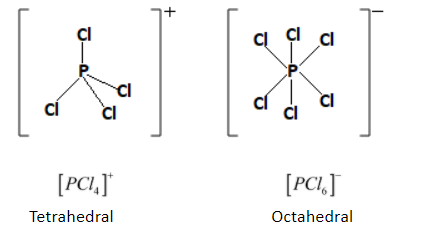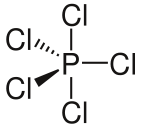
Solid phosphorus pentachloride has the formula
a. Draw a diagram to show the shape of each ion.
b. State the bond angles present in each ion.
Answer
475.5k+ views
Hint: The phosphorus pentachloride is yellowish white-solid and has chemical formula
Complete step by step answer:
The phosphorus pentachloride is a water sensitive solid which is soluble in many organic solvents. In the solid state, it exists as ionic solid which consists of two ions, cation
The ionic solid phosphorus pentachloride has better crystalline structure than that of covalent solid.
a) The positively charged ion, phosphorus tetrachloride
Given below is the shape and structure of cation

b) The angle formed between three atoms and across two bonds in the structure of a compound or ion is termed as bond angle.
The cation
The geometry of anion
Note: The phosphorus pentachloride,

Trigonal bipyramidal structure of
Students should remember that in solid state, phosphorus pentachloride exists in ionic form. Hence, it will not retain the same structure in solid state as that of in liquid and gaseous phase.
Complete step by step answer:
The phosphorus pentachloride is a water sensitive solid which is soluble in many organic solvents. In the solid state, it exists as ionic solid which consists of two ions, cation
The ionic solid phosphorus pentachloride has better crystalline structure than that of covalent solid.
a) The positively charged ion, phosphorus tetrachloride
Given below is the shape and structure of cation

b) The angle formed between three atoms and across two bonds in the structure of a compound or ion is termed as bond angle.
The cation
The geometry of anion
Note: The phosphorus pentachloride,

Trigonal bipyramidal structure of
Students should remember that in solid state, phosphorus pentachloride exists in ionic form. Hence, it will not retain the same structure in solid state as that of in liquid and gaseous phase.
Recently Updated Pages
Master Class 12 Business Studies: Engaging Questions & Answers for Success

Master Class 12 English: Engaging Questions & Answers for Success

Master Class 12 Social Science: Engaging Questions & Answers for Success

Master Class 12 Chemistry: Engaging Questions & Answers for Success

Class 12 Question and Answer - Your Ultimate Solutions Guide

Master Class 11 Business Studies: Engaging Questions & Answers for Success

Trending doubts
Draw a labelled sketch of the human eye class 12 physics CBSE

a Tabulate the differences in the characteristics of class 12 chemistry CBSE

Which one of the following is a true fish A Jellyfish class 12 biology CBSE

Why is the cell called the structural and functional class 12 biology CBSE

Differentiate between homogeneous and heterogeneous class 12 chemistry CBSE

Write the difference between solid liquid and gas class 12 chemistry CBSE




